“They” say variety is the spice of life.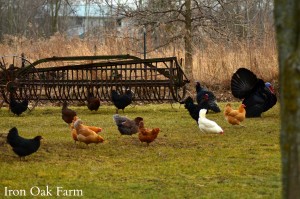
Well then, when it comes to poultry, our farm is very spicy. I must say that I am thoroughly enjoying myself this spring! We have a beautiful assortment of teenage chicks, new chicks, ducks and Narragansett and Bourbon Red turkeys to come. I also have plans for our incubators later this spring. I hope to hatch out a few more Olive Eggers and some Black Spanish turkey poults.
When planning to raise a variety of birds, you have to have space and an organized plan. I’m assuming if you’re considering getting ducks or turkeys that you already have a bit of land and are willing to donate some of that to your different species. But even with endless coops, outbuildings and brooder boxes, things can still get a little hectic.
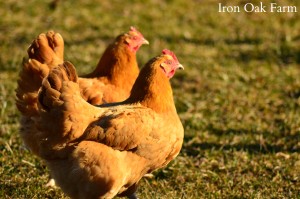 This year I have specific plans for our flock. I am concentrating on two breeds. Buff Orphingtons and Black Jersey Giants. I would like to eventually show these two breeds so I am working on getting some quality breeding stock and work from there. Though Buffs and Jerseys are our focus this year, we did get a few chickens that were fun and different to keep things interesting.
This year I have specific plans for our flock. I am concentrating on two breeds. Buff Orphingtons and Black Jersey Giants. I would like to eventually show these two breeds so I am working on getting some quality breeding stock and work from there. Though Buffs and Jerseys are our focus this year, we did get a few chickens that were fun and different to keep things interesting.
It is ideal to brood each species and each (relative) age group separately. Many species of poultry will do fine together as adults so long as you provide enough space, and food options. But baby birds needs different requirements as they grow which can makes things difficult to plan. Here are some things to consider with each species that we raise and why we brood each species and age group separately.
Age Differences
Chicks can be brooded together within 2 weeks of age. You can also use the amount of feathering to determine if different age chicks can be placed together. If the chicks I have brooding currently have all their wing feathers, then I don’t introduce baby chicks to that brooder. Over all, use common sense. If the younger chicks seem to be trampled by the older ones then they may need to be separated.
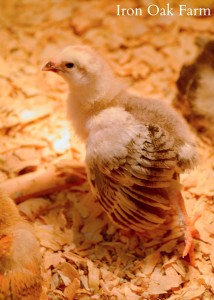
Separate newly hatched chicks until they get their legs working properly. I sometimes add an additional box to the existing brooder until they get their footing before adding them to the rest of the baby flock.
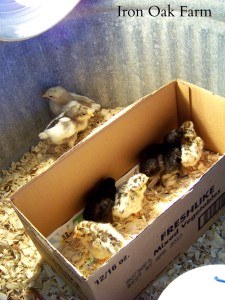
We place older chicks outside in the “teenage” wing of our coop when they are fully feathered. We may provide a heat source depending on what the temperatures are. We’re still getting freezing temps and snow occasionally so they have a source of heat in the wing.
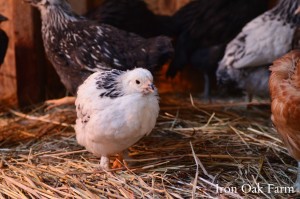
Ducklings
Ducks are probably the most gentle of poultry breeds. Their bill makes pecking less dangerous. However ducks are wet. They get everything in the brooder soggy which creates an unhealthy environment for baby chicks and turkey poults because their feathers are not designed to handle water like a duck.
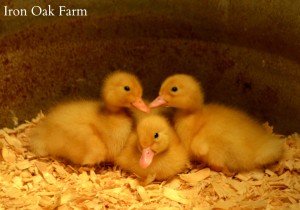
Ducks also grow about three times faster than baby chicks and turkeys, especially Pekins. Our two week old ducks are about twice the size of our 4 week old chicks. Because of the size difference they can easily stomp over baby chicks.
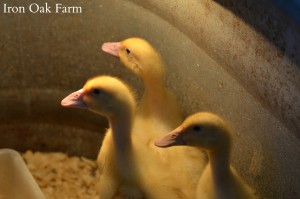
Chicks
Chicks are more territorial than ducks and turkeys and will peck to establish order. Older chicks will also pick on smaller chicks.
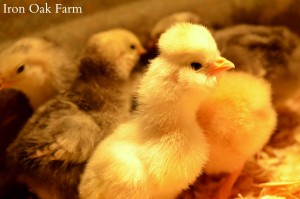
Turkey Poults
Baby turkeys are extremely fragile for the first couple weeks. They move more slowly than chicks and aren’t as aggressive. They also have different food requirements than baby ducks and chicks. Turkeys should be fed a 20% to 24% protein game feed.
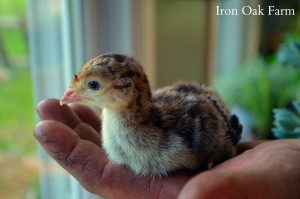
Because of these reasons, we like to provide a separate brooder for each group of birds that come to our farm in the spring. This can mean a lot of jostling but with an organized plan, our spring is an exciting time that I always look forward to. Here are some things we do to stay organized.
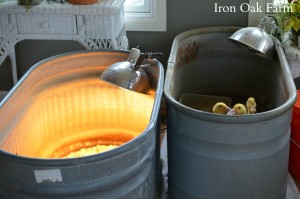
Contact List
I have a word document on my computer with all the breeders, feed stores and suppliers that we’ve used with the farm. If I meet someone or if someone contacts me with information on a breed throughout the year, I always log their information in that document. I also keep records of all the places we’ve acquired animals from. This is especially important with our goats and even beekeepers we’ve worked with.
Start Planning Early
Usually around late February breeders start getting things into place. They start their waiting lists and begin planning what they will hatch for the season. Hatcheries and some feed stores will also do special orders. But it’s important to get your requests in early.
Get a Calendar
Each year I write down when we brought home chicks, when they went outside and any other important dates that have to do with our farm. I also make notes to remember for the following year. When I transfer the calendar I learn from the year before. Perhaps we got chicks too early in the season and they had to be in the house too long waiting for the temperature to warm etc.
With the use of a calendar I have a clear plan as to when a brooder will free up for the next babies to come. For example, our ducklings are almost ready to go outside to the “teenage” coop. Once they’re outside, I will clean the brooder and make it ready for our turkey poults.
Have a backup coop/brooder
It’s always a good idea to have an additional space that you can set up quickly. Sometimes when integrating multiple species or different age levels you will have temperament issues among your flock. It’s nice to have a place where you can put a disagreeable member, or a bird that has been the brunt of over zealous pecking order.
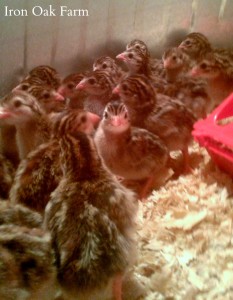 Know when enough is enough and remember that there’s always next year. We considered getting guineas this year. Zach has been talking about them for a few years now. We happened into our local feed store and they had in a batch of guineas. We were both torn. We’ve wanted guineas for a long time, but weren’t planning on them this year. I’m sure we could have set something up and made it work, but we decided that we should stick to our plan and wait till next spring.
Know when enough is enough and remember that there’s always next year. We considered getting guineas this year. Zach has been talking about them for a few years now. We happened into our local feed store and they had in a batch of guineas. We were both torn. We’ve wanted guineas for a long time, but weren’t planning on them this year. I’m sure we could have set something up and made it work, but we decided that we should stick to our plan and wait till next spring.
Sometimes the best way to introduce new species is to do it one spring at a time. For example concentrate solely on ducklings one spring, and then guineas the next.
What animals are you adding to your farm/homestead this year? Do you have any tips for raising different babies throughout the spring? Let us know by leaving a comment below, or visit the Community Chickens Facebook Page.










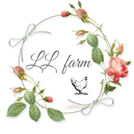

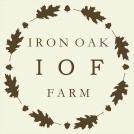
2 Comments
Great article, thanks! I’ve been incubating successive small batch broods (9 to 12) this year since mid June with my last dozen pipping tomorrow. I’ve had chicks as close as 3 days and as far as a week apart. I have our spare bathroom set up as the “chick nursery” with a heavy duty felt-backed table cloth taped down in the bathtub then filled with bedding, then a large brooder plate. I love using the brooder plates because I can adjust the height low on one side for newborns and smaller/slow-to-grow breeds, higher at the other side for the older chicks. Food and water at both ends plus mirrors on the sides because they crack me up when the chicks look at themselves in the mirror!
We have a large brooder den fenced inside the adult flock’s extra large walk-in coop with another large brooder plate, climbing branches, and small pass-throughs plus cubbies in case older chicks try to bully younger ones. As newborns are hatched and added to the bathtub, any chicks old enough to be acting saucy transition to the brooder den. Fully fledged graduate from the den to the coop, again with bolt holes and areas too small for adult chickens.
It’s a constant carousel! The hardest thing is making sure all the littles have access to starter feed (the adults will finish it off given half a chance) and WATER. Keeping clean fresh water low enough for the babies and littles but free from bedding is a constant battle!
But this is our last batch for the year – after last Winter’s power outages we are not willing to go through the angst of trying to keep the babies warm without electricity! We’re ready to have our spare bathroom back, too.
I was planning on placing a few chicks under a broody hen and seeing if she will accept them , any experience with that?